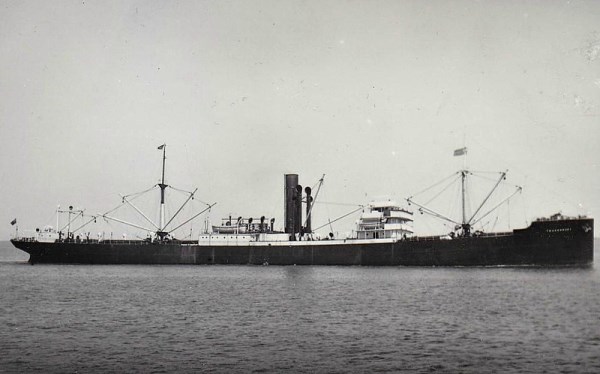Tewkesbury
British Steam merchant

Photo courtesy of Paul Johnson Collection
| Name | Tewkesbury | ||
| Type: | Steam merchant | ||
| Tonnage | 4,601 tons | ||
| Completed | 1927 - Craig, Taylor & Co Ltd, Stockton-on-Tees | ||
| Owner | Capper, Alexander & Co Ltd, London | ||
| Homeport | London | ||
| Date of attack | 21 May 1941 | Nationality: | |
| Fate | Sunk by U-69 (Jost Metzler) | ||
| Position | 5° 49'N, 24° 09'W - Grid ES 5554 | ||
| Complement | 42 (0 dead and 42 survivors). | ||
| Convoy | |||
| Route | Rosario – Montevideo (3 May) - St. Vincent, Cape Verde Islands – Oban | ||
| Cargo | 3548 tons of general cargo, 2000 tons of wheat and 1928 tons of tinned meat | ||
| History | Completed in November 1927 as Glocliffe for Globe Shipping Co Ltd (Humphries Cardiff), Cardiff. 1932 renamed Tewkesbury for Capper, Alexander & Co Ltd, London. | ||
| Notes on event | At 23.42 hours on 21 May 1941 the unescorted Tewkesbury (Master Theodore Pryse) was hit on the starboard side underneath the bridge by one G7a torpedo from U-69 about 540 miles south of the Cape Verde Islands. The explosion threw up a terrific column of water that washed over the ship, sweeping away the starboard jolly boat and pouring water into the engine room through the skylight and ventilators. The men on watch below immediately secured the engines and the crew of 38 men and four gunners (the ship was armed with one 4in and four machine guns) began to abandon ship in two lifeboats when she developed a 10° list to starboard. The master tried to collect the confidential books from the bridge, but found them buried under the collapsed cement protection. He then brought a sextant and chronometer to the starboard lifeboat before abandoning ship in the port boat after helping the chief officer to launch it. Shortly after the boats had rowed away, the U-boat fired a star shell to illuminate the target at 23.58 hours and then commenced shelling the ship from the port bow with 21 incendiary shells, but all failed to ignite upon impact. At 00.36 hours on 22 May, the Tewkesbury was struck on the port side in the stokehold by a coup de grâce and sank by the bow about 7 minutes later. The Germans then left the area without questioning the survivors as the ship had already been identified by her distress signal. The radio officer had managed to send the distress signal several times, so the lifeboat waited 24 hours in the vicinity for assistance but then decided to sail for Fernando de Noronha, about 760 miles to the southwest. In the meantime the master had transferred to the starboard boat and left the chief officer in charge of the port boat, but the boats soon lost contact in the morning of 23 May. On 26 May, the master and 20 survivors were picked up by the American steam merchant Exhibitor in position 05°09N/24°54W. The ship then unsuccessfully searched the area for the other lifeboat in a radius of 30 miles until noon the next day. As she was bound for Bombay, the survivors were transferred to HMS Cilicia (F 54) (Capt V.B. Cardwell, OBE, RN) after a week and eventually landed at Freetown after 12 days. On 2 June, the chief officer and 20 survivors were picked up with their lifeboat by the Antinous (Master Hamilton Powell) in position 04°35N/24°30W and taken to Capetown. All survivors were found in good health. The master Theodore Pryse was awarded the OBE for his actions, but when this was published in the London Gazette he had already been lost while in command of Newbury which was sunk by U-94 (Ites) on 15 Sep 1941. | ||
| On board | We have details of 5 people who were on board. | ||
If you can help us with any additional information on this vessel then please contact us.
